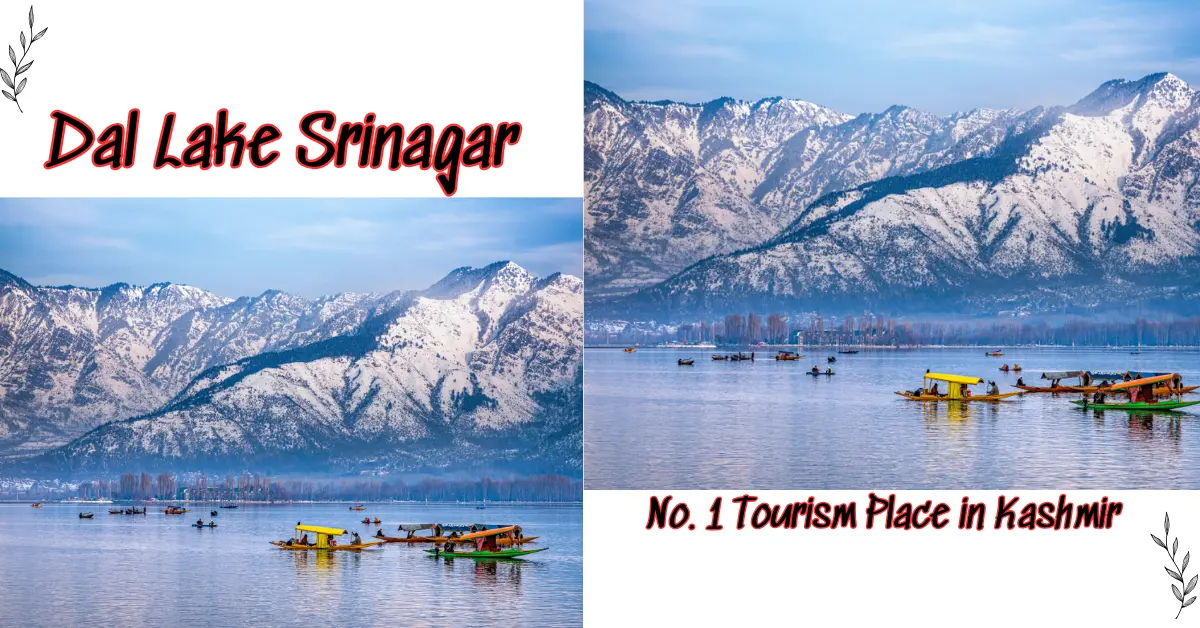
Dal Lake, known as the “Lake of Flowers” and “Srinagar’s Jewel,” spans 18 square kilometers in Kashmir’s Srinagar. It captivates tourists with Mughal-era gardens, houseboats, and scenic vistas, freezing over in winter. Vital for tourism and fishing, it’s part of a 21.1 square kilometer wetland with floating lotus gardens called “Rad.” Divided into four basins, it boasts islands like Rupa Lank and Sona Lank. Facing eutrophication, restoration efforts aim to preserve its charm, ensuring its significance for future generations.
During winters, Dal Lake experiences freezing temperatures, sometimes dropping as low as −11 °C (12 °F), turning the lake into a mesmerizing frozen spectacle. The lake is not only a tourist attraction but also an essential source for commercial activities like fishing and water plant harvesting.

Introduction
Welcome to our blog, where we’ll discuss the amazing beauty and unique charm of Dal Lake in Kashmir, India! If you’re looking for a destination that perfectly combines natural beauty and cultural richness, look no further than Dal Lake, a real gem hiding in the Himalayas. It epitomizes Srinagar’s charm with its natural beauty and cultural richness. Spread over 26 sq km, it’s often called Srinagar’s “jewel,” offering tranquility and stunning views. The iconic houseboats, locally known as “Shikaras,” provide a unique stay experience. Tourists can enjoy leisurely Shikara rides, soak in the picturesque surroundings, and shop from floating vendors selling local crafts and delicacies.
Come and visit this place, where nature and culture blend seamlessly! Enjoy stunning views of snowy mountains reflected in calm waters. Wander through lush gardens and vibrant markets, tasting delicious Kashmiri food along the way. Stay in cozy houseboats that gently float on the lake. Whether you’re cruising in a shikara boat or simply enjoying the tranquility, it offers something for everyone. It’s a place of adventure and relaxation, inviting you to create unforgettable and happy memories.
History & Geography of Dal Lake
Dal Lake, known as Mahasarit in Sanskrit texts, holds a rich history. During the Mughal era, it was developed as a summer retreat with grand gardens and pavilions. After Aurangzeb died in 1707, the Pashtun tribes and later the Afghan Durrani Empire influenced the region until Maharaja Ranjit Singh annexed it in 1814. Under Dogra Raj, Srinagar became the capital, with the cool climate attracting attention. Despite restrictions on construction, British-built houseboats became a unique feature on Dal, earning it the moniker “Jewel in the crown of Kashmir.” Post-independence, Kashmiri Hanji people maintained these houseboats, central to their livelihoods and tourism in Srinagar.
The stunning Dal Lake is situated within a vast catchment area of 316 square kilometers, cradled in the Zabarwan mountain valley. Surrounded by the majestic Shankaracharya Hill on three sides, it sprawls over 18 square kilometers, expanding to 21.2 square kilometers with its floating lotus gardens. The lake’s main basin comprises five interconnected sections – Nehru Park, Nishat, Hazratbal, Nigeen, and Barari Nambal – connected by navigational channels. At an average elevation of 1,583 meters, its depth varies from 6 meters at Nigeen to 2.5 meters at Gagribal. Spanning 7.44 kilometers in length and 3.5 kilometers in width, the lake’s shoreline stretches 15.5 kilometers, bordered by roads.
However, urban development has altered its flow, leading to the emergence of marshy lands, notably around Shankaracharya and Zaharbwan hills, now transformed into residential areas.
The Main attractions
It is more than just beautiful scenery. It’s surrounded by interesting places to see. There are three islands in the lake, and the shores are lined with lovely Mughal gardens. Hills are on one side of the lake, and from Shankaracharya Hill, you get a great view of the lake.
It is not only a scenic wonder but also a hub of activities and cultural heritage in Srinagar. It’s a popular destination for tourists seeking relaxation and adventure. Fishing and plant harvesting are crucial, with lake weeds converted into compost for gardens. Additionally, it acts as a flood buffer for the Jhelum River. From swimming to boating, and even snow skiing in winter, there’s no shortage of water sports. The lake’s surroundings are dotted with cultural landmarks like the Shankaracharya temple, Nigeen Lake, and Hazratbal Shrine, enriching visitors with Srinagar’s rich heritage. A ride on a houseboat or shikara boat is a quintessential experience, earning Dal Lake the moniker “the Gondola of Kashmir.”
House Boats
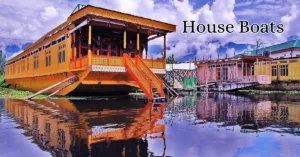
Houseboats are like floating homes on Dal Lake. They’re cozy and beautifully decorated with Kashmiri style. You can stay in them and enjoy modern comforts while surrounded by the peaceful waters. From the deck, you can see amazing views of the lake and watch life on the water. Visitors can stay overnight in these traditional floating accommodations, enjoying the atmosphere of the lake while enjoying warm hospitality and breathtaking views of the surrounding landscape.
Floating Gardens

Floating gardens are a unique feature of Dal Lake, where plants and soil are woven together to create floating islands. When lotus flowers bloom in July and August, it looks amazing. The floating gardens, called “Rad,” are interesting too. They’re made by gathering plants and earth from the lake and tying them together. People make them by tying together plants and soil from the lake. They grow lots of fruits and veggies like tomatoes and cucumbers. You can see them from the road that runs along the lake.
Shikara Rides
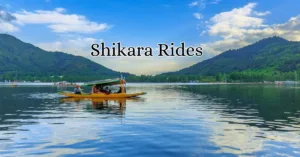
One of the best ways to see the lake is by riding in a Shikara boat. You can take a ride and see the Mughal gardens from the water. It’s a relaxing and enjoyable way to spend time in Srinagar. These traditional wooden boats glide gracefully across the serene waters, offering visitors a leisurely way to discover hidden corners, observe daily life on the lake, and admire the picturesque scenery from a unique perspective.
Floating Post-Office
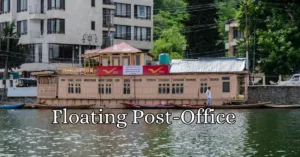
The floating post office on Dal Lake was opened in 2011 by Omar Abdullah, the former Chief Minister of Jammu and Kashmir. Situated on the western side of Dal Lake, it was previously known as Nehru Park post office. Visitors can purchase postcards from Ghat no -1, Budiyar Chowk, and the floating post office affixes postage stamps on them. Additionally, plans are in place to establish a philately museum at the site.
Great Restaurants
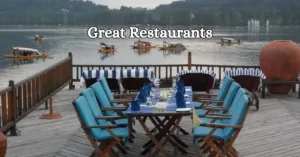
Restaurants at Dal Lake offer a unique dining experience on the water, serving delicious Kashmiri cuisine:
- Mughal Darbar: A renowned restaurant on a houseboat, serving authentic Kashmiri dishes like Rogan Josh and Dum Aloo, amidst the serene ambiance of Dal Lake.
- Ahdoos: Known for traditional Kashmiri delicacies such as Wazwan and Gushtaba, prepared with authentic local spices and ingredients.
- Lhasa Restaurant: A popular Tibetan eatery near Dal Lake, offering a fusion of Tibetan and Kashmiri flavors alongside Tibetan specialties.
Summary

Highlights:
– Enjoy scenic Shikara rides, stay in traditional houseboats, explore floating gardens and markets, and visit the serene Mughal gardens.
Timings:
– Open from 6 A.M. to 6 P.M.
Entry Fee:
– Not applicable.
Tips:
– Visit from May to November for the best experience.
– Plan for 2 to 3 hours to explore Dal Lake.
Restricted Items:
– Avoid bringing plastic bottles and bags, drones, fishing equipment, loudspeakers and amplifiers, and fireworks.
Transportation Details:
1. By Air:
– Dal Lake is conveniently located 17 km away from Sheikh ul Alam International Airport in Srinagar.
2. By Train:
– If traveling by train, Dal Lake is approximately 14 km from Srinagar Railway Station.
3. By Road:
– By road, the distance from Lalchowk Srinagar to Dal Lake is approximately 5 km, making it easily accessible by local transportation or taxi services.
Dal Lake is surrounded by the foreshore and boulevard roads on three sides, offering easy access for travelers. Several ghats along these roads serve as boarding points for Shikaras, which function as water taxis for navigating the lake. In terms of transportation connections, Dal Lake benefits from its location within Srinagar. Dal Lake is easily accessible by road and air. The nearest airport, located in Badgam, is approximately 12.8 kilometers away and offers flights to major cities across the country. For rail travel, Srinagar railway station is the closest, situated around 18.8 kilometers from Dal Lake.
The National Highway NH1A links the Kashmir valley to the rest of the country, facilitating road travel to and from Dal Lake. These transportation options ensure convenient access for visitors to this iconic destination in Jammu and Kashmir.
Some Nearby Destinations
In Jammu and Kashmir, people visit holy places like Vaishno Devi and Amarnath, as well as ancient monasteries like Alchi and Stongdey. Wildlife lovers can explore parks like Dachigam and Hemis, while trekkers enjoy routes like the Indus Valley Trek. Beautiful lakes like Dal Lake and Manasbal Lake offer peaceful spots, and Leh Ladakh is famous for its Buddhist monasteries. You can find hotels easily in Jammu, Katra, Srinagar, Gulmarg, Pahalgam, and Leh Ladakh.
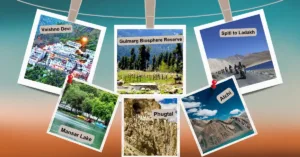
Pilgrimage Sites
- Vaishno Devi
- Amarnath
- Alchi
- Padum
- Stongdey Monastery
Wildlife Sanctuaries
- Dachigam National Park
- Gulmarg Biosphere Reserve
- Hemis High Altitude Wildlife Sanctuary
- Kishtwar High Altitude National Park
Trekking Routes in the Himalayas
- Indus Valley Trek
- Pahalgam to Amarnath
- Spiti to Ladakh
- Srinagar-Daksum-Kishtwar
- The Nubra Valley Trek
Lakes
- Dal Lake
- Manasbal Lake
- Mansar Lake
- Nagin Lake
- Wular Lake
Buddhist Monasteries in Leh Ladakh
- Alchi
- Chemrey Gompa
- Diskit & Hundur
- Hemis
- Lamayuru
- Likir
- Matho
- Namgyal Tsemo Gompa
- Phugtal
- Rangdum
- Rhidzong
- Sani
- Sankar Gompa
- Shey
Some Useful Tips
- Best Time: May to November is ideal for houseboat stays, with pleasant weather.
- Protect Nature: Don’t throw garbage in the lake to keep it clean.
- Choose Carefully: Pick a houseboat approved by the Houseboat Owners Association (HOA) for safety.
- Enjoy the Ride: Take a colorful Shikara ride to the floating post office for a unique experience.
- Relax: Enjoy the peaceful surroundings of Dal Lake for a calming break.
FAQs
1. How do I plan a trip to Dal Lake?
– Research accommodations and activities.
– Decide on travel dates and book transportation.
– Pack essentials like warm clothing, a camera, and comfortable shoes.
– Consider hiring a local guide for a better experience.
2. How should I spend my time at Dal Lake?
– Take a Shikara ride to explore the lake’s beauty.
– Visit the floating market and shop for local crafts.
– Stay in a houseboat & enjoy
– Enjoy leisurely walks along the lakeshore.
– Visit nearby places – Mughal gardens & shrines.
3. What are the best times to visit Dal Lake?
– The best time is from April to June for a visit and have pleasant weather.
– Autumn Season (September to November)
– Avoid visiting during winter (December to February) due to cold temperatures and frozen lakes.
4. What activities can I do at Dal Lake?
– Enjoy boating, including Shikara rides and kayaking.
– Explore the floating gardens and marketplaces.
– Visit nearby attractions like Mughal gardens and temples.
– Take photography tours to capture the scenic beauty.
– Attend cultural events and festivals if available.
5. How do I travel to Dal Lake?
– Fly to Srinagar Airport and then take a taxi or bus to Dal Lake.
– Alternatively, you can reach Srinagar by train and then hire local transportation.
– Consider booking a tour package that includes transportation and accommodation for convenience.
Also Read:
Discovering 5 Best Places to Visit in India in April
Explore the Best Places to Visit in India In 2024
References:
https://en.wikipedia.org/wiki/Dal_Lake
https://srinagar.nic.in/tourist-place/dal-lake/
Disclaimer: This article is for informational purposes only. While we strive to provide accurate and up-to-date information, please verify details with official sources. My BlogPod is not responsible for any inaccuracies or changes in the information presented.
Related post

5 Tips for Planning the Perfect Weekend Getaway

7 The Best Solo Travel Destinations for Women

